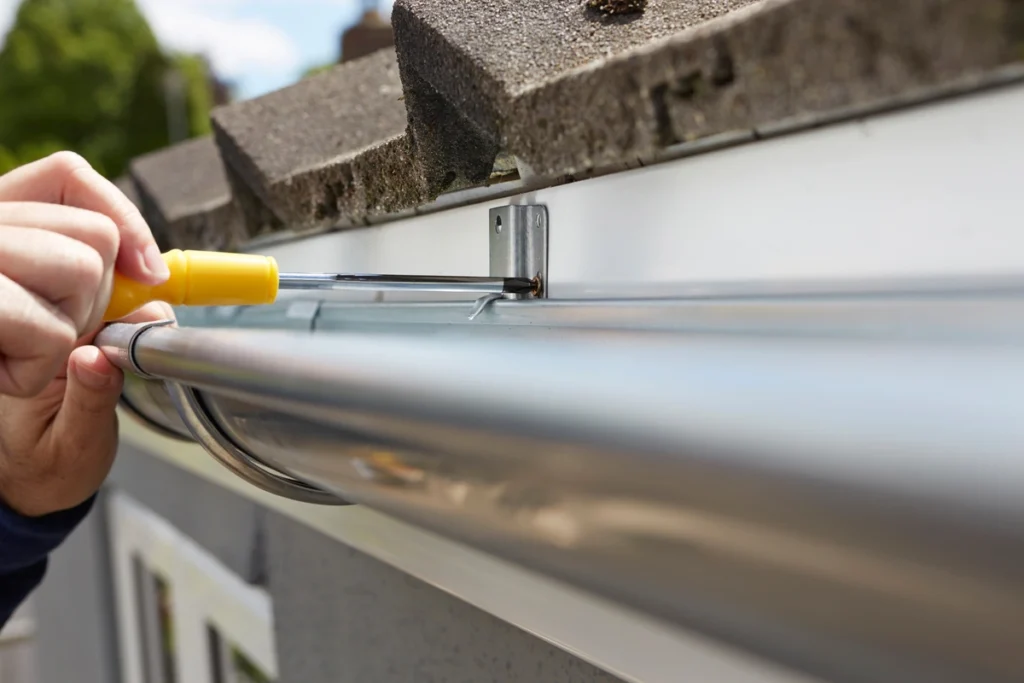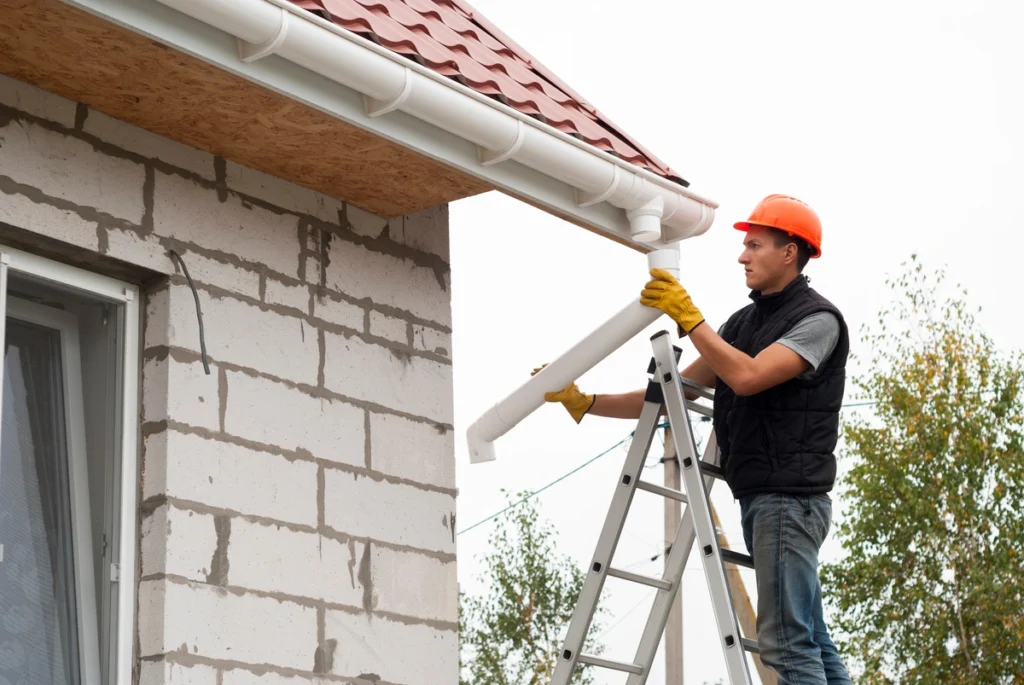Welcome to your one-stop guide for DIY gutter installation. Forget about the daunting prospect of professional services and buckle up, because we’re going on a journey to transform you into your very own rainwater control expert!
In this comprehensive guide, we’ll break down the straightforward process of installing your own gutters yourself; from choosing your preferred type of gutters, maybe between metal and vinyl options, maximizing water flow with accurate downspout locations, right through to sealing with a reliable gutter sealant.
You’ll learn how even crucial elements like end cap caps or hanging brackets can be managed in-house, potentially saving hundreds on professionally installed gutters.
Benefits Of Installing Gutters

Installing gutters has numerous benefits for homeowners, including diverting rainwater away from the foundation to prevent damage, protecting the landscaping from erosion and waterlogging, and safeguarding the exterior of the home against potential water damage.
Diverting Rainwater Away From The Foundation
One of the primary benefits of installing gutters is their function in diverting rainwater away from your home’s foundation. This is significantly important as it protects the structural integrity of your house.
In addition to causing soil erosion, accumulated water can also increase hydrostatic pressure against a basement wall, leading to numerous issues like leaks or even cracks in walls.
For instance, imagine coming home after a strong storm only to discover that your once cozy basement has turned into an unwelcome indoor pool! To avoid such costly and stressful situations, properly functioning gutters are essential.
Protecting The Landscaping
Maintaining the aesthetic appeal and health of your home’s landscaping can be a challenging task, especially in areas prone to high rainfall. By installing gutters – particularly with the addition of effective gutter guards – you essentially erect a protective shield for your landscape.
Imagine creating a picturesque garden around your house only for it to wash away due to uncontrolled water runoff from heavy rainfalls. Gutters assist by channeling this water towards appropriate areas such as drains or rain barrels.
For example, directing downspouts into rain barrels not only saves your garden but also provides an eco-friendly option for reusing water.
Preventing Water Damage To The Exterior Of The Home
Proper gutter installation plays a crucial role in preventing water damage to the exterior of your home. Imagine, during a heavy downpour, rainwater cascading off your roof directly onto your siding or foundation.
This can lead to unsightly water stains, eroding landscaping work, and in severe cases – structural damage that requires extensive repairs.
A properly installed gutter system works as an effective shield for your dwelling. Like an unseen hero, it channels rainwater away from vulnerable areas such as rafter tails and fascia boards towards designated downspout locations.
For instance, consider installing steel gutters or seamless vinyl gutters with end caps on all ends to ensure complete enclosure of the gutter run. Utilize adequate hanging brackets and chalk lines for precise placement ensuring proper gutter slope for optimal water flow.
In essence DIY Gutter Installation adds an essential layer to safeguard against potential costly damages while elevating the longevity of your precious abode.
Steps To DIY Gutter Installation

In this section, we will outline the three essential steps to successfully install gutters yourself: measuring and planning the complete gutter system out, gathering necessary tools and materials, and installing the gutter brackets.
Measure And Plan The Gutter System
To ensure a successful DIY gutter installation, it’s crucial to start with accurate measurements and careful planning as well as any additions such as installing gutter guards. Begin by measuring the length of each section where you want to install gutters, taking into account any corners or bends.
This will help determine the overall length of the gutter system you’ll need.
As you plan your gutter system, consider factors such as landscaping features that may affect water drainage and potential obstacles like windows or doors.
Taking these precise measurements and carefully considering your home’s layout will help guide you in selecting the right materials and quantities needed for a successful DIY gutter installation project.
Gather The Necessary Tools And Materials
To ensure a successful DIY gutter installation, it’s crucial to gather all the necessary tools and materials beforehand.
Some essential gutter replacement tools you’ll need include a cordless drill, crimper, duckbill tin snips, an extension ladder for accessing higher areas, a hex head driver for attaching screws, offset tin snips for cutting metal gutters, and a pop rivet gun for securing components together.
In addition to the tools, you’ll also need specific materials to complete the project. This includes gutter material such as metal or vinyl gutters that fit your desired specifications.
When planning your DIY rain gutter installation project, be sure to consider additional supplies like power tools and safety equipment such as gloves and goggles.
Remember that proper preparation is key in any DIY project – having all the necessary tools and materials ready will help make installing new gutters into a smoother experience overall.
Install The Gutter Brackets
To ensure your gutters are securely attached to your home, it’s important to properly install the gutter brackets. These brackets act as support systems that hold the weight of the gutters and help old gutters maintain their structural integrity.
To begin, measure and mark the placement of the brackets along the fascia board at regular intervals, ensuring they are evenly spaced. Next, use a drill to create pilot holes for each bracket before securing them in place with screws or nails.
One crucial tip when installing gutter brackets is to consider the slope of your gutters. The proper angle to hang gutters allows rainwater to flow smoothly towards the downspouts without any pooling or stagnation issues.
Lastly, keep in mind that different types of gutters may require specific bracket styles or sizes. For instance, metal gutters might require galvanized steel brackets while vinyl gutters may need specialized plastic hangers.
By following these guidelines for installing gutter brackets, you can ensure a sturdy foundation for your entire gutter system, helping divert rainwater effectively away from your home and preventing potential water damage issues.
Attach The Gutters And Downspouts

Now that you have installed the gutter brackets, it’s time to attach the gutters and downspouts. Start by positioning the gutters on top of the downspout brackets, making sure they are level and aligned correctly.
Use 1 1/4″ self-tapping hex head screws to secure sheet metal screws in the gutters to the brackets.
Once the gutters are securely attached, it’s time to connect them with downspouts. Cut a hole in one end of the downspout holes on each gutter run using offset tin snips or a hole saw.
Next, position a downspout outlet over each hole and trace its outline onto the gutter.
Attach downspout elbows at any corners where water needs to change direction.
Finally, connect your downspouts by sliding one end into another until they click in place.
Remember, proper attachment is key in ensuring your own rain gutters will function effectively in diverting rainwater away from your home’s foundation and preventing damage.
By following these simple steps and using quality materials such as snap layout lines”, “gutter sections”, “strip miter joint,” you can successfully attach your gutters and downspouts like a pro without having to rely on professional gutter installation companies and services.
Conclusion
In conclusion, this homeowner’s guide to installing gutters (DIY) has provided you with the necessary steps and tips to tackle this project with confidence. By diverting rainwater away from your foundation, protecting your landscaping, and preventing water damage to your home’s exterior, installing gutters offers numerous benefits.
With proper measurement and planning, gathering the right tools and materials, and following the step-by-step instructions outlined here, you can successfully install your own gutter guard system.
If you’d prefer leaving it to a professional, contact Rankin County Custom. They offer free same-day evaluations and 24/7 emergency services, and are GAF Master Elite.

